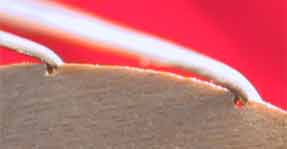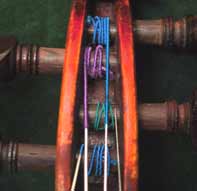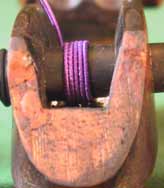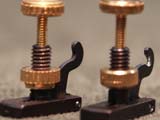If the string slots in the bridge or top nut are too narrow, the strings will not slide through them during tuning. This can cause strings to break.

The notches are too small for the strings (exaggerated for demonstration purpose) |

The notches are correct

The notches are darkened with a soft pencil
As mentioned previously, applying a small amount of graphite from a soft pencil to the bridge and top nut notches allows the strings to slide more easily and last longer.

The slot is too narrow for the string to pull through
If the slots in the tailpiece are too narrow, strings cannot be pulled all the way through so that the ball on the end of the string seats into position. This can cause strings to break.

The string should not be pinched against the wall (in the above picture, the violin's D-string is undesirably pinched against the wall)
When a string is pinched against the side of the pegbox,the friction can break the string, or worse, crack the pegbox.

Insufficient space for the string between peg and bottom of pegbox
Strings can also become squeezed between the peg and the bottom of the pegbox, especially where a string is doubled on the peg. This not only can cause the string to break, but can also damage the peg and the hole in the pegbox.

Topnut too angled

Topnut too flat

Correctly shaped topnut
If the top nut does not have the correct curve, it can force the string to bend at a sharp angle on either side of the topnut. This stresses the string and it can break.

Some fine tuners have sharp edges that cause E strings with looped ends to break. A violinmaker can round off these edges.
When tuning your instrument, try not to go above the correct pitch of the string as this will stress the string, making it break sooner. This picture shows tuners with sharp square edges
|

